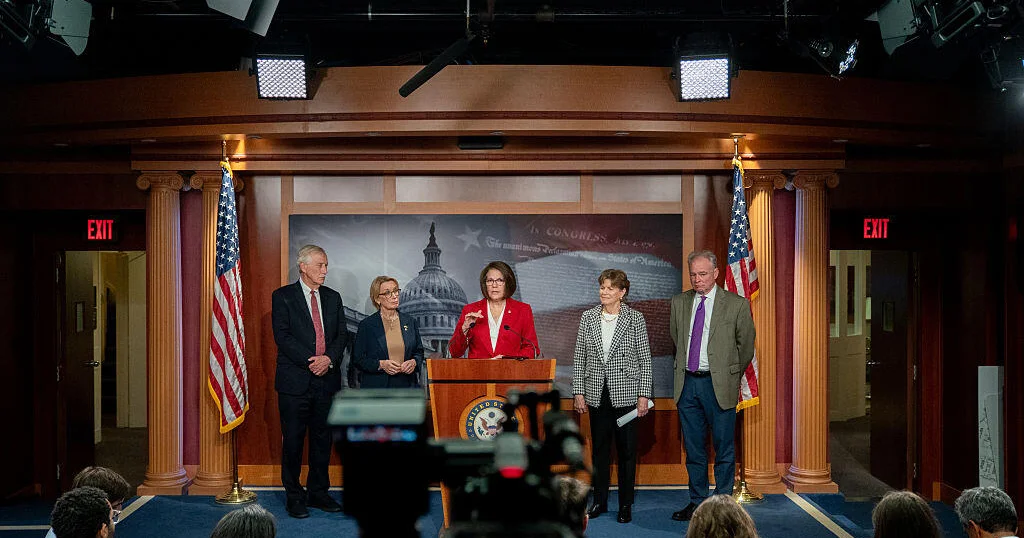In a recent development, seven Democratic senators and one independent have unanimously voted for a plan aimed at reopening the government and concluding the ongoing shutdown. This decision follows a series of votes and negotiations that unfolded over the last several weeks. The initiative involves a continuing resolution that serves to extend government funding until January, while also addressing a range of pressing issues, notably the Affordable Care Act tax credits.
| Article Subheadings |
|---|
| 1) Overview of the Government Shutdown |
| 2) Key Players in the Vote |
| 3) Details of the Proposed Resolution |
| 4) Implications of the Vote |
| 5) Future Steps and Considerations |
Overview of the Government Shutdown
The government shutdown, which has impacted countless federal operations and services, has been a growing concern for both citizens and lawmakers alike. With tensions escalating over budgetary disagreements, particularly surrounding funding for health care and social support programs, the stalemate forced many federal employees into uncertainty over their livelihoods. The decision to reopen the government comes as a relief, especially for the millions of citizens reliant on government services, which had been curtailed during the shutdown. The passage of the continuing resolution is a significant step toward normalcy for federal operations.
Key Players in the Vote
Among the notable figures pushing for government reopening was John Fetterman of Pennsylvania. He has been vocal about the shutdown and consistently supported Republican proposals aimed at keeping the government funded, marking his alignment with bipartisan efforts. Alongside him, Catherine Cortez Masto of Nevada expressed her concerns about how the shutdown affects her constituents, arguing that it provides undue leverage to a “reckless administration.” Independent senator Angus King from Maine also played a pivotal role in negotiations, asserting the need for a strategic approach to the situation. These senators, among others, showcased a blend of bipartisan support essential for advancing the funding measure.
Details of the Proposed Resolution
The resolution in question not only aims to keep the government funded until January but also includes specific provisions regarding the Affordable Care Act tax credits. The senators agreed to a compromise that allows for a vote on these crucial subsidies, reflecting a broader concern for healthcare access while also staving off extended disruptions from the shutdown. Moreover, critical appropriations bills will be included to ensure long-term funding streams for essential services. This nuanced agreement aims to minimize the adverse effects previously faced by federal employees and citizens alike during the protracted shutdown.
Implications of the Vote
The approval of this resolution is expected to have wide-reaching implications for federal operations. It not only aids in preventing further disruptions but also serves as a platform for legislators to re-negotiate various healthcare-related measures that have been left hanging in the balance. Furthermore, it marks a collaborative effort, showcasing the necessity of bipartisan strategies to address federal funding issues. The commitment from Senate Democrats and the independent caucus illustrates a united front in confronting the repercussions of prolonged governmental inactivity.
Future Steps and Considerations
As lawmakers look towards the upcoming months, additional steps are necessary to solidify the funding measures. Though the Senate has agreed to the short-term plan, discussions will continue to address the core differences in legislative priorities that led to the initial shutdown. Legislative leaders must remain vigilant in future negotiations to ensure that all stakeholders are represented and that appropriate funding for essential services is established without recurring shutdown threats. The focus will likely shift to upcoming elections as many senators who supported this resolution are up for reelection, prompting calls for accountability in addressing the issues raised by constituents during the recent shutdown.
| No. | Key Points |
|---|---|
| 1 | The government shutdown has drawn bipartisan attention, prompting a united effort among several senators to reopen the government. |
| 2 | Senators John Fetterman and Catherine Cortez Masto have been vocal advocates for resolving the funding issues quickly to assist affected constituents. |
| 3 | The proposed resolution includes measures for protecting Affordable Care Act tax credits and reversing layoffs during the shutdown. |
| 4 | The decision to reopen the government has been framed as a crucial step to mitigate adverse impacts on federal services and employees. |
| 5 | Future negotiations will need to focus on legislative priorities to avoid similar shutdowns while ensuring necessary appropriations are maintained. |
Summary
The recent Senate vote to reopen the government marks a pivotal moment in resolving the ongoing shutdown. With bipartisan support, this initiative not only aims to stabilize federal operations in the short term but also sets the stage for future legislative discussions around crucial issues such as healthcare and social programs. The willingness of several senators to cross party lines exemplifies a necessary collaboration in times of crisis. As the nation looks forward, the emphasis will remain on sustaining open lines of communication and negotiation to prevent further disruptions.
Frequently Asked Questions
Question: Why did the government shut down in the first place?
The government shutdown occurred due to a lack of agreement among lawmakers on budgetary issues, particularly concerning funding for health care and social services. Disagreements over these priorities led to a lapse in appropriations and essential funding.
Question: What does the continuing resolution entail?
A continuing resolution is a type of appropriations legislation that allows for the funding of government agencies at previously established funding levels for a specified period to avoid disruptions in services.
Question: How will this resolution affect federal employees?
The resolution aims to reverse layoffs resulting from the shutdown and ensure that affected federal workers receive back pay, thus mitigating the financial impacts of the shutdown on their livelihoods.
